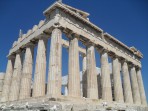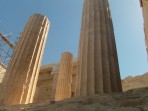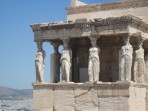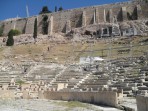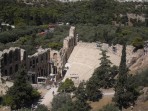Athens - capital city
History of Athens
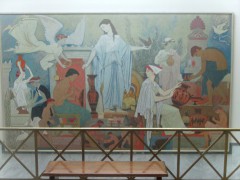
The history of the capital city of Athens goes very deep into the past, as the city has been continuously inhabited for more than three thousand years and in the 1st millennium BC Athens became the capital and most important city of ancient Greece. The cultural and social achievements of Athens during the 5th century BC laid the foundations of Western civilisation.
1) First settlement
The first traces of human habitation on the Athenian Acropolis and in the Agora area below date back to the Neolithic period around the 5th millennium BC (according to some research, even as early as the 7th millennium BC). The foundation of the city of Athens then dates back to the 3rd millennium BC.
According to legend, the Athenian king Cecrops (half man and half serpent according to mythology) first named the city after himself, but the gods, seeing the beauty of the place, began to compete with each other and tried to impress the local population as much as possible. Poseidon struck the rock with his trident, and when water gushed out of it, he assured the inhabitants that they would never suffer from drought again. Athena, next in line, threw a seed into the ground and it grew into a beautiful olive tree. The people were more appreciative of Athena's gift because Poseidon's water was said to be salty. Athena thus became their patroness and the city was named after her.
2) Antiquity
At the beginning of the Mycenaean period (roughly 1550 to 1100 BC), large fortresses began to be built throughout Greece, and Athens was no exception. A royal castle was built on the Athenian Acropolis around 1400 and its remains can still be seen today. Athens at this time was becoming a sovereign city-state, initially ruled by kings.
During this period Athens became a powerful centre of Mycenaean civilisation.
As the land here was not particularly fertile, the city became more oriented towards maritime trade. Athens also benefited from its advantageous geopolitical position, being located on the mainland of Greece, but also having very good access to the sea and, in terms of defensibility, a secure fortress on the Acropolis.
Athenian government and laws
The written history of Athens began to be recorded in the 8th century BC, when the country and the Greek government were dominated by wealthy aristocrats. The first set of laws to address the existing problems were drawn up by the statesman Draco (in 621 BC). The essence of Draco's laws was the distinction between intentional and unintentional acts. However, his laws were considered too harsh, as the common punishment for most misdemeanors and violations was death. The familiar term "draconian" was applied to such severe punishments.
The great legislator Solon was therefore called upon to revise Draco's laws. Solon, though himself an aristocrat, created a series of laws that balanced the political power of the citizens. Under Solon's constitution, all citizens were allowed to participate in the judiciary. Citizens were divided into four classes according to the size of their property, and all classes were allowed to participate in elections; thereafter, only representatives of the first two classes (pentakosiomedimnoi and hippeis) could be elected to office. Solon also set up the so-called Council of Five Hundred, which allowed new classes of the population (merchants and artisans) to begin to participate in political power. Slavery was abolished.
Solon's reforms thus addressed both political and economic issues, and through them Solon laid the foundations for what we call 'Athenian democracy' in 594 BC. In the short term, however, he failed to suppress the conflict between the social classes and a popular party led by Peisistratus (Solon's cousin) took power.
In 547 BC, Peisistratos established personal rule (tyrannis) in Athens. Peisistratos is therefore often called a tyrant, but the Greek word "tyrannos" does not mean a cruel and despotic ruler; it merely refers to one who took power by force. Peisistratos, on the other hand, was a rather popular ruler who made Athens a powerful cultural centre and established Athenian naval supremacy not only in the Aegean. As a ruler, he also upheld the basic principles of the Thessalonian Constitution.
During his reign the development of the city continued and Peisistratos began to build a temple on the Acropolis dedicated to the goddess Athena. Architecturally, it was a so-called hekatonpedon, or hundred-foot temple (the temple measured 100 feet in length, or about 33 m). Under Pericles, the temple was rebuilt and later the Parthenon was built on its site.
The Golden Age
After the Athenians (with the help of the Plataeans) defeated the Persians at the Battle of Marathon in 490 BC and repelled a second Persian invasion at Salamis in 480 BC, Athens became the greatest naval power in Greece. Under the leadership of Pericles, the Athenian Empire could also effectively influence its neighbours in Attica and the Aegean islands.
Under Pericles (460-430 BC), Athenian democracy flourished and Athens entered its golden age. Great thinkers, writers and artists settled in the city. Herodotus, the father of history, lived and wrote in Athens. Socrates, the father of philosophy, taught here and Hippocrates, the father of medicine, worked here. Democritus came up with the idea of an atomic universe. Phidias created great statues for the Parthenon and for the Temple of Zeus at Olympia (one of the Seven Wonders of the Ancient World). Aeschylus, Euripides, Aristophanes and Sophocles made Greek tragedy and Greek comedy famous.
The Acropolis and its surrounding area also gradually began to fill with huge buildings - the Parthenon temple was built on the site of an older temple, a new temple of Erechtheum, the Propylaea, a smaller temple of Athena Nike and others. One of the landmarks of the Acropolis at that time was the huge statue of the goddess Pallas Athena.
The remains of some of these magnificent buildings have survived to the present day, you can read more about them in the article The Most Famous Historical Monuments of Athens.
Pericles ruled Athens until his death in 429 BC. A few years later, however, Athens' position of power collapsed.
Greek Wars
Against the hegemony of Athens, a coalition of landlocked states led by Sparta gradually formed. The Peloponnesian War between Athens and Sparta (431-404 BC), which at the same time directly or indirectly affected virtually all of Greece, was a major disaster for Athens. After the defeat, Athens disappeared as an empire of power and wealth and lost its dominion over the sea. At least the city retained its reputation as a centre of Greek philosophy, learning and culture, for the 4th century BC was a period of great philosophers.
However, Sparta's overly imperialistic policies became a thorn in the side of its former allies, and soon Athens' former enemies Thebes and Corinth became its new allies. Athens, in alliance with Argos, Thebes and Corinth, fought Sparta in the indecisive Corinthian War (395-387 BC). Opposition to Sparta eventually allowed Athens to establish the Second Athenian League. Eventually Thebes defeated Sparta in 371 BC at the Battle of Leuctes. Thereafter, the Greek cities, including Athens and Sparta, turned against Thebes, whose dominance was halted at the Battle of Mantinea (362 BC).
However, around mid-century the northern Greek kingdom of Macedonia grew in dominance, and two centuries of Macedonian rule over Athens followed.
The Roman Empire
In 146 BC, Greece comes under the rule of the Roman Empire. However, Athens benefited from its special status during this period, as Roman statesmen rather admired Athens and continued to promote Greek culture there. Emperor Hadrian, for example, built a new quarter in Athens, a huge library, new baths and numerous aqueducts, and completed the temple of Zeus of Olympus. The Roman Emperor Nero also visited Athens several times.
The wealthy Athenian Herodotus Atticus, who became a Roman senator and built the great theatre Odeon of Herod Atticus under the Acropolis of Athens, also contributed to the new look of Athens. The huge Odeon stands on the same site today.
Religion underwent a great change as Athenian paganism slowly gave way to Christianity, which later became the official religion of the Roman Empire.
In 395, Greece, including Athens, became part of the Eastern Roman Empire (or Byzantine Empire). However, in the 3rd and 4th centuries Athens had to face raids by marauding Goths, and in the 5th century by the invading Huns. The Greeks also failed to defend themselves effectively against the barbarians during this period.
3) The Middle Ages
Central Greece was one of the most advanced parts of the Byzantine Empire and Athens was in its economic heyday at this time. The cultural and philosophical centre of the country, however, began to shift more towards Constantinople.
In the field of architecture, numerous Christian buildings were newly appearing. Christianity emerged early in Athens, symbolically beginning in 51 AD with the arrival of the apostle Paul. At this time, however, there was only a small Christian community, which was not very visible. In the 5th and 6th centuries, however, after the official establishment of Christianity, pagan manifestations were abandoned and churches began to be built. In some cases, ancient temples were used and converted into Christian buildings (e.g., the Parthenon, the Erechtheum, and the Temple of Theseus). The new churches were built with the plan of a basilica and had a wooden roof, of which only the foundations survive today.
From the 11th century onwards, and especially in the 12th century, Athens entered a period of steady growth. The agora (marketplace), abandoned since late antiquity, began to revive and soon the city became an important producer of soaps and dyes. The development of the city attracted Venetians and other merchants travelling through the Aegean ports. The 11th and 12th centuries represented a golden age for Byzantine art in Athens. During these two centuries almost all the most important Byzantine religious buildings around Athens were built.
During the Crusades, Athens benefited mainly from trade with Italy. However, the medieval prosperity of Athens was not to last long, for in 1204, during the Fourth Crusade, the medieval city was conquered. And until the 19th century, Athens was under the domination of foreign powers. Between 1204 and 1458, Athens was under the administration of the Latin Empire, and the whole period is sometimes divided by historians into three stages, which could be called: a) the Burgundian period, b) the Catalan period and c) the Florentine period.
During these periods the appearance of Athens underwent only slight changes, one of which was the addition of a bell tower to the Parthenon.
4) Turkish domination
After the siege by the Turkish army, Athens came under the rule of the Ottoman Empire in 1458. When the Ottoman Sultan Mehmet II, the conqueror of the city, saw Athens' ancient monuments, he forbade looting and destruction. The Parthenon became a mosque and its bell tower was converted into a minaret, the Propylaea was occupied by a Turkish governor and the Erechtheum temple served as a harem. Other mosques sprang up in the lower part of Athens.
Despite the initial efforts of the Ottoman rulers to make Athens a model provincial city, the population declined significantly and by the 17th century Athens was little more than a small village. In general, by the 17th century Ottoman power was already in decline, and the appearance of the city was also damaged by the practice of Ottoman soldiers storing gunpowder in Athenian monuments including the Parthenon and the Propylaea. In 1640, the Propylaea were destroyed due to an explosion. The damage to the Parthenon (which has influenced the present-day appearance of the monument) occurred in 1687 when Athens was besieged by the Venetians and a shot fired during the bombardment of the Acropolis caused the explosion of the stored gunpowder.
The temple of the goddess Athena Nike was destroyed. Several other Athenian monuments were damaged or destroyed to provide material for a new defensive wall built by Ottoman soldiers around Athens in the second half of the 18th century.
5) Modern History
Building a "new" Athens
It was not until 1832 that Athens once again became part of the independent modern Greek state, and two years later Athens was established as the capital of Greece (1 January 1834). At that time, however, it was a virtually uninhabited city, as there was only a cluster of a few buildings at the foot of the Acropolis (today's Athens' Plaka district). Athens thus became the capital for historical and sentimental reasons rather than because it was the largest Greek city. However, as soon as it was declared the capital, a new building and development plan was drawn up and new public buildings began to be constructed.
Thus, at this time, for example, the University of Athens (1837), the Old Royal Palace (now the Greek Parliament building; 1843), the National Garden of Athens (1840), the National Library of Greece (1842), the Greek National Academy (1885), the Zappeion Exhibition Hall (1878), the Old Parliament building (1858), the new Royal Palace (now the Presidential Palace; 1897), and the Athens City Hall (1874) were built.
In 1896 Athens hosted the first modern Olympic Games.
During the First World War, Athens was occupied by occupying forces for a time (1916 to 1917), but fortunately was spared aerial bombardment. The 1940s saw a dark period in Athens, with large numbers of people starving to death during World War II and the German occupation, and the whole city began to decay and fall apart. Moreover, after the Germans left, a civil war broke out in Athens.
Population growth
Meanwhile, in the 1920s, after the Greco-Turkish War, many Greek refugees from Asia Minor flooded Athens. There was a Greek-Turkish population exchange and a large number of ethnic Greeks settled in the area around Athens, establishing small, poor villages that are now part of Athens as the urban districts of Nea Ionia, Nea Smyrni, Nea Chalkidona, Nea Erythrea, Nea Filadelfia or Kalithea.
The city then experienced further population growth in the 1950s and 1960s, as people from the war-ravaged countryside and the Greek islands moved to the capital for work, and Athens' suburban districts in particular grew. 1981 was also a milestone for the Greek population, when Greece became a member of the European Union. EU accession brought Greece a flood of new investment on the one hand, but also an increase in social and environmental problems on the other.
In the 1980s, Athens unfortunately worked its way up to being described as the European city with the worst traffic jams and the most polluted air. The sheer inadequacy and dysfunctionality of public transport was also one of the reasons why Athens failed in its bid to host the 1996 Olympic Games.
The Olympic Games were finally held in Athens in 2004, and during this interim period Athens underwent huge changes - in addition to the construction of new sports venues, the local transport infrastructure was greatly improved, including the introduction of a new tram system, and a new international airport opened in 2001.
In mid-2010, Athens (or Greece as a whole) faced a new challenge in the form of a wave of migrants and refugees fleeing the unrest in Africa and the Middle East. Since then, Greece has continued to face this problem with varying degrees of intensity.
Today, Athens is one of the world's capitals and a major tourist destination. For tourist tips and interesting facts about the capital, see the separate article Athens Tourist Guide.

